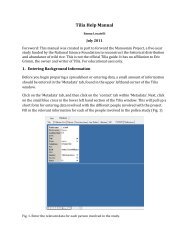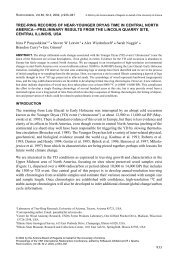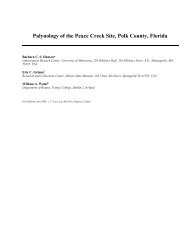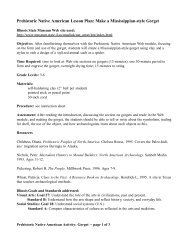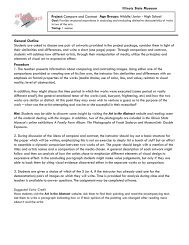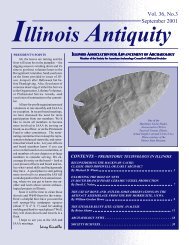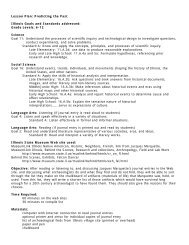Outdoor Photography Lesson Objective - Illinois State Museum
Outdoor Photography Lesson Objective - Illinois State Museum
Outdoor Photography Lesson Objective - Illinois State Museum
You also want an ePaper? Increase the reach of your titles
YUMPU automatically turns print PDFs into web optimized ePapers that Google loves.
Sunshine and Shadow: <strong>Outdoor</strong> <strong>Photography</strong> <strong>Lesson</strong><br />
<strong>Objective</strong>: Students will take outdoor photographs that incorporate the play of sunlight and shadow in a<br />
composition to evoke emotion, sense of place, or formal values.<br />
Motivation: Frank Sadorus was very interested in how photographic film could record light and shadow.<br />
His outdoor photographs contained the play of light and dark across the composition, to dramatize a<br />
composition, and to add details to his compositions. Snow, ice, sky, clouds, water, and textured areas<br />
(such as tree bark) were often featured as his choice of subject matter. Students can experiment with<br />
camera effects and with their choice of compositions to create these light effects.<br />
Grade Level: Middle School and up<br />
Time required: one class period to photograph; one period to critique finished photos.<br />
(Students could also mount and display best photos with comments in an exhibit or online, on a CD, etc.)<br />
Online Collection:<br />
http://www.museum.state.il.us/ismdepts/art/Sadorus/ Sadorus Collection<br />
Other Sadorus Resources:<br />
http://www.museum.state.il.us/muslink/art/htmls/dd.html Double Exposure module<br />
Bial, Raymond. 1983. Upon a Quiet Landscape. Champaign County Historical Archives, Urbana, <strong>Illinois</strong><br />
<strong>Photography</strong> Resources:<br />
http://www.saugus.net/Photos/photography_tips.shtml Tips on <strong>Photography</strong><br />
http://www.ephotozine.com/techniques/viewtechnique.cfm/recID/174 Tips on snow photography<br />
http://photographytips.com/page.cfm/160 <strong>Photography</strong> tips on light.<br />
Materials:<br />
Digital or disposable cameras<br />
Computer (with writable CD drive or web site)<br />
blank CD<br />
Software to manipulate images<br />
(Photoshop, et al)<br />
Display Board for critique<br />
Mounting supplies (mats, frames)<br />
Motivation:<br />
Frank Sadorus was interested in<br />
capturing different effects with light<br />
and shadow. There are four basic<br />
lighting situations:<br />
• Direct light comes from one<br />
direction. It creates hardedged,<br />
dark shadows as a spot<br />
light on a stages does. The sun<br />
is a big spot light, too.<br />
Sadorus’s After a Spring Snow<br />
Storm demonstrates direct<br />
lighting.
• Directional diffused lighting comes basically from one direction with some light that has<br />
been diffused or scattered from other angles. Edges are softer and shadows have more<br />
detail.<br />
• Fully diffused light comes from many directions and shows very little or no directionality.<br />
Shadow edges are indistinct and the subject seems surrounded by light. Sadorus’s Elmer<br />
with Cat is an example of this type of lighting.<br />
• Silhouette lighting is the back-lighting of<br />
a subject so that the contour of the<br />
subject is sharp, but the details toward the<br />
viewer are in shadow. Sadorus’s GWB in<br />
Window is an example of silhouette<br />
lighting.<br />
Students can do this, too. Things to keep in mind with<br />
outdoor lighting are:<br />
• Clear, sunny days with bright light produce<br />
dark, strong shadows.<br />
• On overcast days or at dusk light will be<br />
diffused and soft. This is a nice light for<br />
portraits because it molds the planes of<br />
faces and softens skin. Many photographers<br />
love to shoot at dusk because of<br />
this.<br />
• In the morning and late afternoon when<br />
the sun is low in the sky, there are long<br />
shadows and an increased sense of texture<br />
and volume.
Procedure:<br />
• Students will look at Frank Sadorus’ photographs on the <strong>Museum</strong>’s web site. Class discussion<br />
of chosen images will focus on his capture of light, shadow, and contrast.<br />
• Teacher reads <strong>Photography</strong> Tips and presents principles to students with examples of lighting.<br />
• Students go outside (school grounds, home, field trip, etc) and take photographs, keeping<br />
principles in mind.<br />
• Photographs are developed professionally (or digital ones downloaded into computer).<br />
• Prints are displayed on a board for a critique of their composition’s use of light and dark. Each<br />
student can describe what he/she was trying to capture. Peers can comment on what the<br />
images evoke as they view the image.<br />
• Students choose their best image and mount it for display or for a CD or Web site. (They can<br />
also manipulate their image in photo software to enhance their composition, either before or<br />
after the critique.)<br />
Assessment:<br />
Student, peer and teacher comments are recorded for each photographer to learn from (if this works with<br />
your class).<br />
Students may self-assess with a point system or critique in a group as to how they rate their own<br />
and others’ compositions with regard to:<br />
1) balance of contrast in the composition;<br />
2) creation of a discernible mood or feeling through use of light and dark;<br />
3) how they manipulated their image to adjust contrast to create the mood they wanted.<br />
<strong>Illinois</strong> <strong>State</strong> Board of Education Goals:<br />
Art:<br />
Middle School: 25.A.3e Analyze how the elements and principles can be organized to convey meaning<br />
through a variety of media and technology.<br />
Early High School: 25.A.4 Analyze and evaluate the effective use of elements, principles and expressive<br />
qualities in a composition/performance in dance, drama, music and visual arts.<br />
Late High School: 25.A.5 Analyze and evaluate student and professional works for how aesthetic<br />
qualities are used to convey intent, expressive ideas and/or meaning.<br />
Middle School: 26.A.2f Understand the artistic processes of printmaking, weaving, photography and<br />
sculpture.<br />
Early High School: 26.A.3e Describe how the choices of tools/technologies and processes are used to<br />
create specific effects in the arts.<br />
Late High School: 26.A.4e Analyze and evaluate how tools/technologies and processes combine to<br />
convey meaning.



